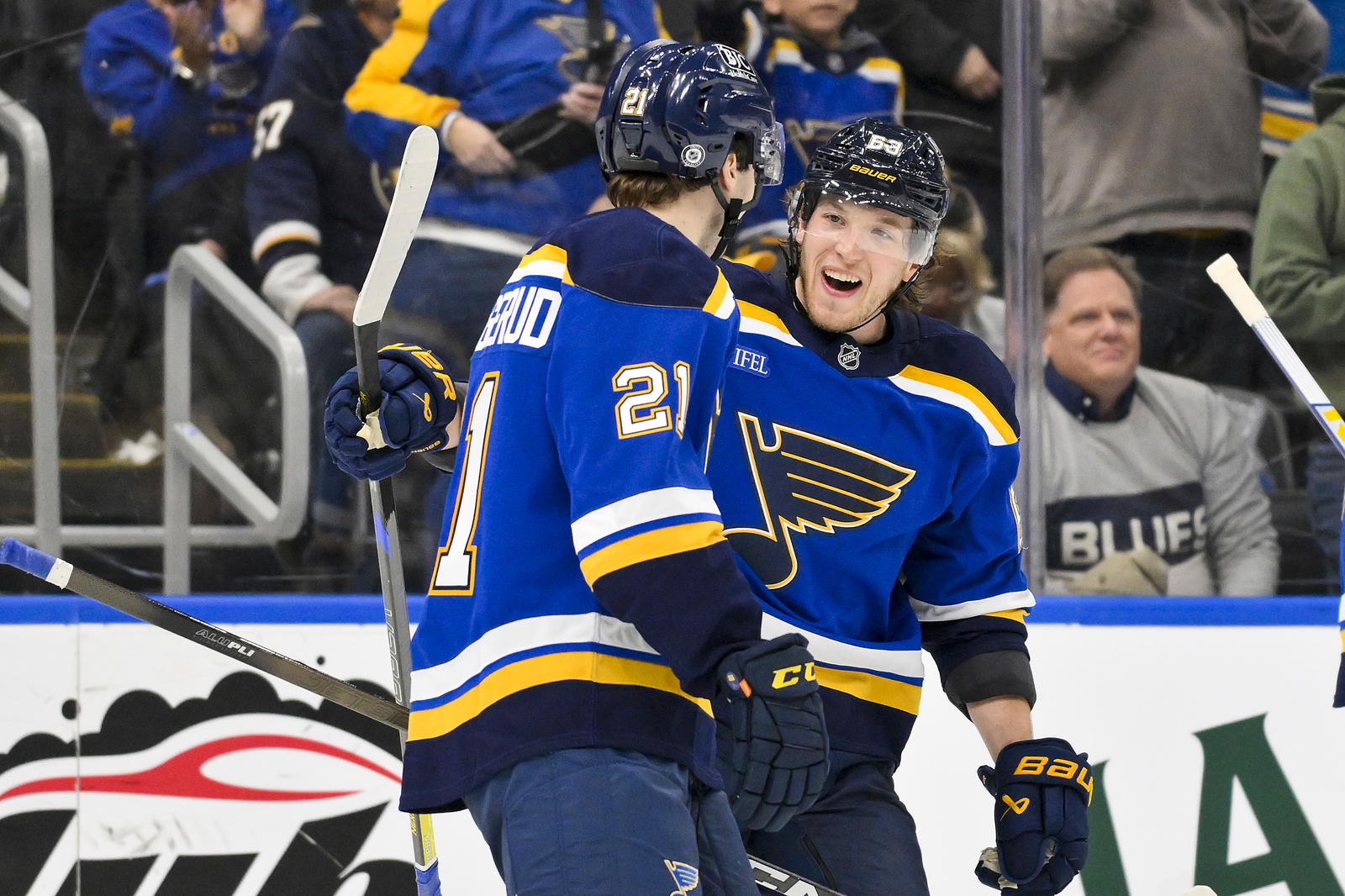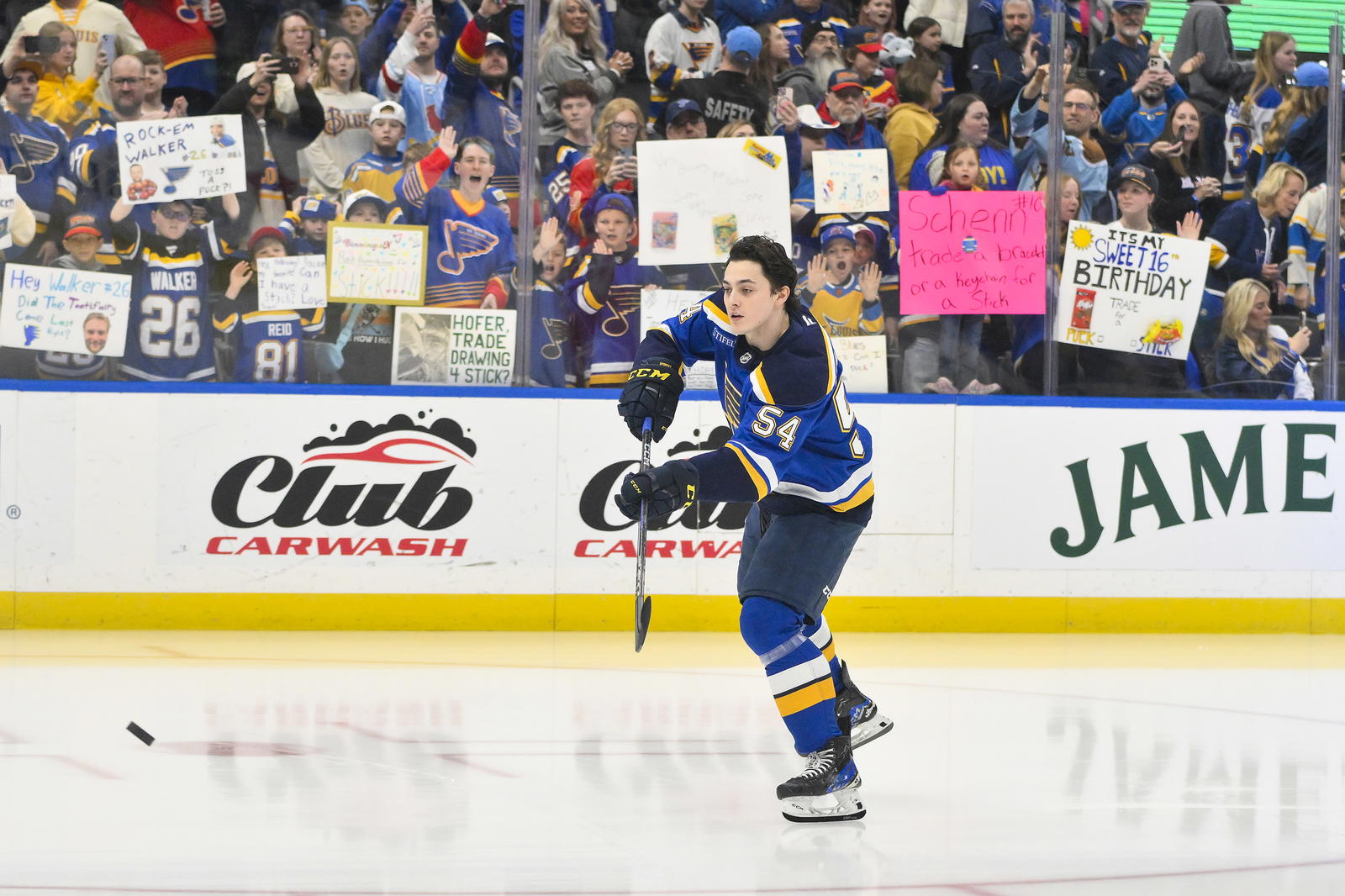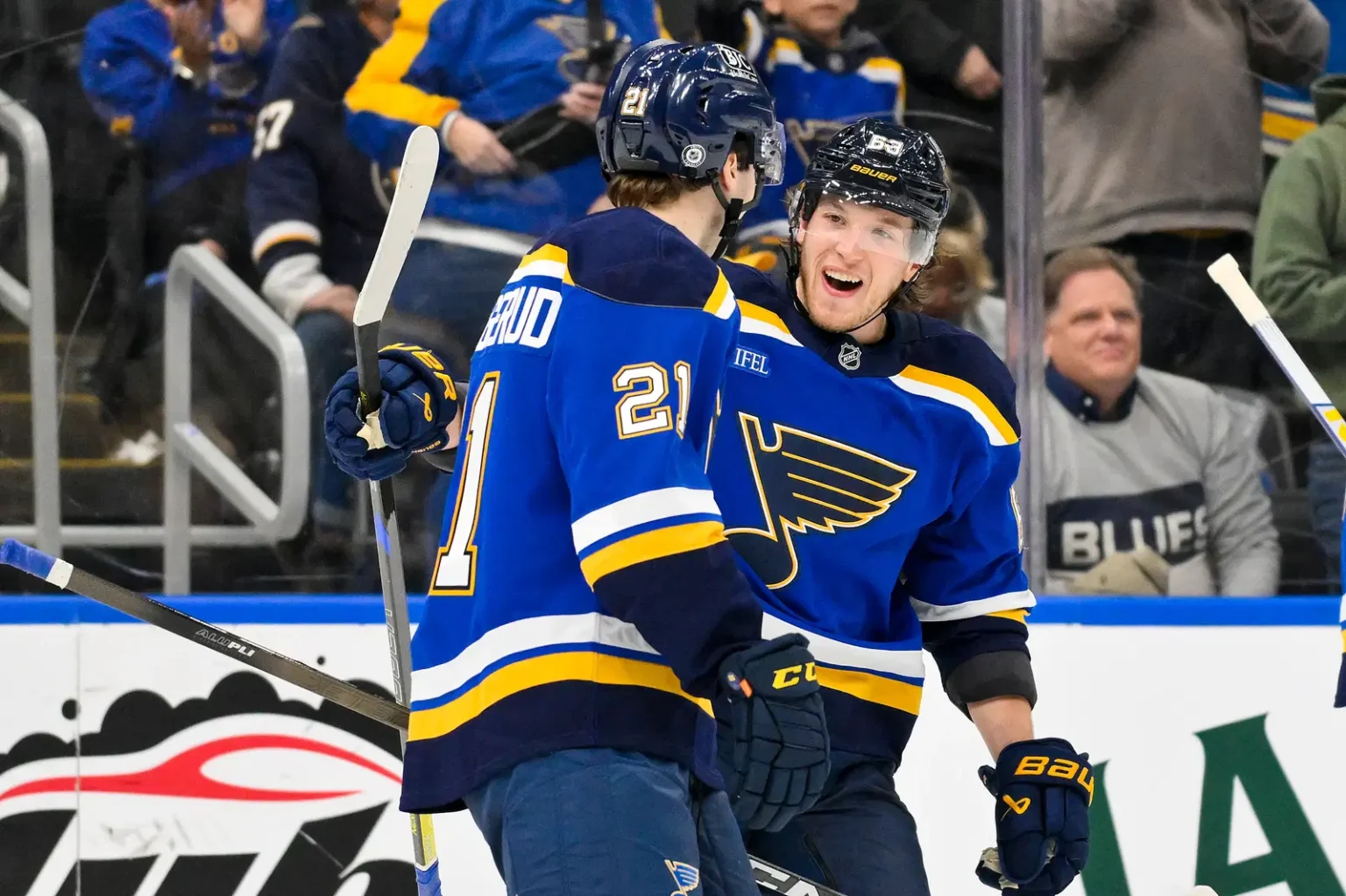The Hockey News has released its archive to all THN subscribers: 76 years of history, stories, and features.
Subscribe now to view the full THN Archives here.
Also, go to thn.com/free to subscribe.
By Ken Campbell
For most NHL GMs, the World Junior Championship provides an opportunity to get in a quick scouting trip at a relatively soft time in the schedule. So, they tend to come in like a visiting potentate for a few days, watch a couple of their prospects, shake some hands and kiss some babies, then beat a hasty retreat to allow their scouting staff to do the boots-on-the-ground heavy lifting. But not St. Louis Blues GM Doug Armstrong, who spent enough time in Sweden in late 2023 and early 2024 to apply for landed immigrant status.
“I got there early,” Armstrong said, “and I stayed there late.”
There’s a really good reason why Armstrong, who is in his 30th season of having an executive parking spot with an NHL hockey-operations department, approached the WJC in Gothenburg with the zeal of a kid with a handful of hockey cards and a fresh Sharpie. It’s because his team had seven prospects playing in the tournament, and they weren’t 13th forwards or seventh defensemen. They were serious contributors, none more so than defenseman Theo Lindstein, the third of three first-round picks the Blues had last year (the 29th overall selection, which St. Louis picked up from the New York Rangers in the Vladimir Tarasenko trade). Lindstein was originally cut by the Swedes, then started the tournament as a depth defenseman. Twenty-five seconds into the first game of the tournament against Latvia, Swedish blueliner Elias Salomonsson took a major and a game misconduct for boarding, which resulted in a suspension in the second game. Lindstein took advantage of the increased role, led all defensemen in scoring with two goals and eight points and was named to the tournament all-star team with a silver medal around his neck.
Lindstein’s teammate, center Otto Stenberg, finished the tournament second in goals for Sweden with five, right winger Jimmy Snuggerud had eight points for the juggernaut U.S. team, center Dalibor Dvorsky and left winger Juraj Pekarcik were solid contributors for Slovakia, Aleksanteri Kaskimaki had four points for a disappointing Finnish team and Jakub Stancl of Czechia signed Canada’s death warrant with two goals in the quarterfinal, including the game-winner with 11 seconds remaining. One of the things that has Armstrong excited is that five of the players were taken in the 2023 draft. Since each of the five 2023 Blues draftees to play at the WJC was born in 2005, that means they’re all eligible to return to the 2025 tournament. “And with some of the other guys we have,” Armstrong said. “We could have six or seven guys from (the 2023) draft there next year, along with whomever we pick up this year.”
It’s been a long time since the Blues have had a prospect pool this deep and this impressive. A really, really long time. When they took Dvorsky 10th overall in 2023, it represented the first time since the 2008 draft they picked in the top 10. Their second of three first-rounders was Stenberg, who was chosen with the pick the Blues got in the large haul they received from the Toronto Maple Leafs for Ryan O’Reilly and Noel Acciari. Then, faced with the prospect of losing Ivan Barbashev after the season, Armstrong dealt Barbashev to the Vegas Golden Knights at the deadline for Zach Dean, who put up solid numbers in junior hockey as a two-way center and is learning how to be a pro in the AHL this season.
That was the one positive to the Blues dropping out of the playoff race before the trade deadline last season. Had they still been in contention, they could have pointed to, well, themselves and convinced themselves that after what happened in 2019, anything is possible. But being out of the playoff picture allowed them to trade away O’Reilly, Tarasenko, Barbashev and Acciari for futures, which Armstrong believes actually accelerated the process by a couple of years.
And so the Blues are now on a different path. Armstrong will not use the word “rebuild” on account of the fact it seems to be a term that turns current season-ticket holders into former ones. It’s also not a rebuild when you go into the All-Star Weekend holding down the last wild-card spot in the Western Conference. And you can’t really claim you’re in a rebuild when you have a 32-year-old Torey Krug, a 31-year-old Justin Faulk and a 30-year-old Colton Parayko each taking up $6.5 million in cap space for the next three seasons. That’s not to mention a 32-year-old Nick Leddy occupying $4 million in cap allocation for each of the next two seasons. (For those keeping score at home, that’s $23.5 million in cap space until the end of 2025-26 claimed by four defensemen who are 30 or older.)
But Armstrong actually has pretty apt verbiage for the course the Blues find themselves taking these days. “It started, quite honestly, a year earlier than we thought,” Armstrong said. “If we had had a good year last year, we would’ve kept those players and got nothing for them. The silver lining in a bad year last year was that we were able to start our re-whatever-this-is a year earlier and with more assets.”
A re-whatever-this-is won’treally fit on a promotional brochure, but Armstrong is wise to frame it that way. With what the Blues have coming, they feel good about their long-term future. Along with the youngsters, Robert Thomas is only 24 and Jordan Kyrou and Scott Perunovich are 25, and 21-year-old Jake Neighbours – whose name sounds like he should be a character on The Andy Griffith Show – seems to be settling into the NHL quite nicely, thank you very much. So, perhaps it’s more of a rebuild on the fly. One of the good things about having all those older guys on long-term deals is they have serviceable placeholders on the roster – expensive and difficult-to-trade placeholders, but placeholders nonetheless – until the youngsters are ready for prime time. Plus, the salary cap is going up, and don’t forget, kids, the long-term injury list can be a wonderful tool.
They aren’t the only legitimate prospects the Blues have, but the seven players who played in the WJC gave the organization a tangible indication that it is on the right track. Success in this tournament is not a guaranteed harbinger of future NHL success, but it certainly beats having a bunch of prospects who weren’t good enough to take part in a best-on-best tournament for their age group. It’s particularly useful for gauging the progress of European prospects, many of whom are playing against men in their home countries and playing bottom-six minutes as forwards or No. 4 or 5 roles as defensemen. The World Junior Championship has always been a good barometer of where your young players stand in comparison to their peers. And in the case of the Blues’ young players, there was a lot to like. And while the idea that the WJC is not a tournament for 18-year-olds has shifted over the years, it’s heartening to see that so many players with a year remaining of junior eligibility compared so favorably against some of the best under-20 players in the world (with the exception of the eligible players in the NHL and, this is a big one, the best under-20 Russian players).
“It’s not a 100-percent fact, but it’s an indicator,” Armstrong said. “As an evaluator, all you can evaluate is what you see. I’m a big believer in, when it’s best-on-best, that’s a pretty good indicator of how players will perform later on. When you’re given the opportunity to play against the best players, how you do there is a pretty good indicator.”
THE SILVER LINING IN A BAD YEAR LAST YEAR WAS THAT WE WERE ABLE TO START OURRE-WHATEVER-THIS-IS EARLIER AND WITH MORE ASSETS– Blues GM Doug Armstrong
–
Prior to the tournament, Armstrong made a trip to Europe to see Lindstein, Stenberg and Kaskimaki. Lindstein has spent most of this season with Brynas in Sweden’s second-division Allsvenskan, while Stenberg has played regularly with SHL Frolunda and Kaskimaki with HIFK in Finland’s Liiga. Sweden, in particular, is notorious for sheltering teenage pros and keeping them firmly on the fourth line. It’s difficult to argue with the results, since most young Swedish players who aren’t rushed into the NHL show up ready to compete in the world’s best league and prove to be both very good and incredibly low maintenance.
“They’re sheltered players on their club teams for sure,” Armstrong said. “You’re going to get that when they’re 18- and 19-year-old players playing with men. But you watch them and you say, ‘The way they’re playing with the opportunity they’re getting, if you translate that against their peer group, they could have good tournaments.’ I’m really proud of the way they performed because they did transfer what they were learning playing against men to their peer group.”

Of all the Blues’ prospects, the most ready to make the jump is Snuggerud, the son of former NHLer Dave Snuggerud. Even though he was born 11 years after his father last skated in The Show, there is no denying that bloodlines and NHL experience that can be passed on give a player an advantage. The 2024 WJC was Snuggerud’s second, after finishing third in scoring in the 2023 tournament behind only Connor Bedard and Logan Cooley. Playing with Cooley and Matthew Knies on the top line at the University of Minnesota in 2022-23 as a a freshman, Snuggerud finished fifth in NCAA scoring and sat 10th overall in goals this season without his two high-scoring linemates. There’s a very good chance this year will be the last Minnesota sees of Snuggerud, who is primed to be signed at the end of his college campaign and will likely get in some games with the Blues before the end of the season.
Essentially, the Blues and Snuggerud will have to balance the risk of rushing things – something neither side wants – against the notion that there might not be anything more for the player to accomplish at the college level. When Dylan Larkin signed with the Detroit Red Wings just before his 19th birthday and after one season at the University of Michigan, Wings GM Ken Holland told Larkin and his parents that if he was looking out the window of a bus on a winter night pulling into Grand Rapids, they’d have to remember they made the decision to turn pro.
“You always want to have one thing where you can say, ‘This is an NHL-caliber skater; this is an NHL-caliber competitor; this is an NHL-caliber faceoff guy,’” Armstrong said. “He’s an NHL-caliber shooter. He obviously has to have other parts of the game there, but when you’re walking in with one NHL-caliber attribute, you have something to hang your hat on.”

The other intriguing prospect is Dvorsky, who dropped out of the top five in the 2023 NHL draft but continues an impressive run of young Slovak talent. Dvorsky had spent the past two seasons playing in Sweden – getting into 55 pro games with AIK in the Allsvenskan. Ahead of the 2023-24 season, Dvorsky moved up to the SHL with Oskarshamn. But there, Dvorsky saw limited ice time and failed to score a point in 10 games, so he decided to come to North America. He joined the OHL’s Sudbury Wolves, where he was among the league leaders in points per game. Everything he’s shown suggests a high skill level and the potential to be an offensive difference-maker. But as Armstrong points out:
“You don’t want a 90-point player who is minus-30.” So, there is a lot of work to do, but there’s also a lot of time to do it – especially for a player who can provide offense. “It wouldn’t have been a wasted year if he had stayed (in Sweden), but he’s probably in a better place now than he would have been if he had been a bit player on a struggling team,” Armstrong said. “When you’re picking in that area of the draft, you’re looking for players who can make a difference offensively, and he has all of those top-of-the-circle-down skills that you need to be good. That’s how we see him, and that’s how we project he’s going to excel. Now, it’s our job to work with him on the teachable things.”
So, now the Blues, for the first time in a while, have a critical mass of prospects and some real bulk to their futures list. Development, of course, is critical at this point. And it’s also where players go from being top prospects to players who can actually contribute at the NHL level. Prior to coming to St. Louis, Armstrong had worked for years with the Dallas Stars, and he has long lived by the words of former Stars assistant GM Les Jackson, who maintained that when players don’t work out, more often than not, it’s the team that fails the player and not the other way around.
I’M A BIG BELIEVER IN, WHEN IT’S BEST-ON-BEST, THAT’S A PRETTY GOOD INDICATOR OF HOW PLAYERS WILL PERFORM LATER ON– Blues GM Doug Armstrong on the WJC
–
And that’s why timing is so important. There are not too many players out there who suffered from being brought along at a slow and methodical pace, but there are a lot of examples of players who didn’t work out after being brought along too quickly and placed in situations and roles for which they weren’t prepared. And although you might want to follow “a pack mentality” as Armstrong calls it, putting all your prospects in the same place to grow together, either in the NHL or the minors, the reality is that no two players are the same. Thomas became a full-time NHL player at 19, won a Stanley Cup as a rookie and has never looked back. Kyrou spent time shuttling between the AHL and the NHL for his first two pro seasons and is now a point-per-game player. Goalies always take a little longer, but before Joel Hofer earned the backup job with the Blues this season, he had spent three full seasons in the minors, one of which included a run to the Calder Cup final with the Springfield Thunderbirds.
The thing Armstrong doesn’t want to do is accelerate the development process to prove that he made some good trades. Barbashev and Tarasenko were popular players who helped the Blues win the first and only Stanley Cup in franchise history, but the assets they were able to get in exchange for their expiring contracts could help the club contend again. But only if the prospects are brought along at a pace that suits them. To be sure, the players involved will have a lot of say in that process by how they perform, but it will also be dictated by the support they get from the Blues.
“We don’t want to fail our players by putting them in positions to fail,” Armstrong said. “We want to give them the opportunity to succeed, and that means we’re in for the marathon. And if it takes until 2025-26 or ’26-27 for these guys to be comfortable playing in the NHL, then we’re OK with that.”
Read the full article here



